Paper Menu >>
Journal Menu >>
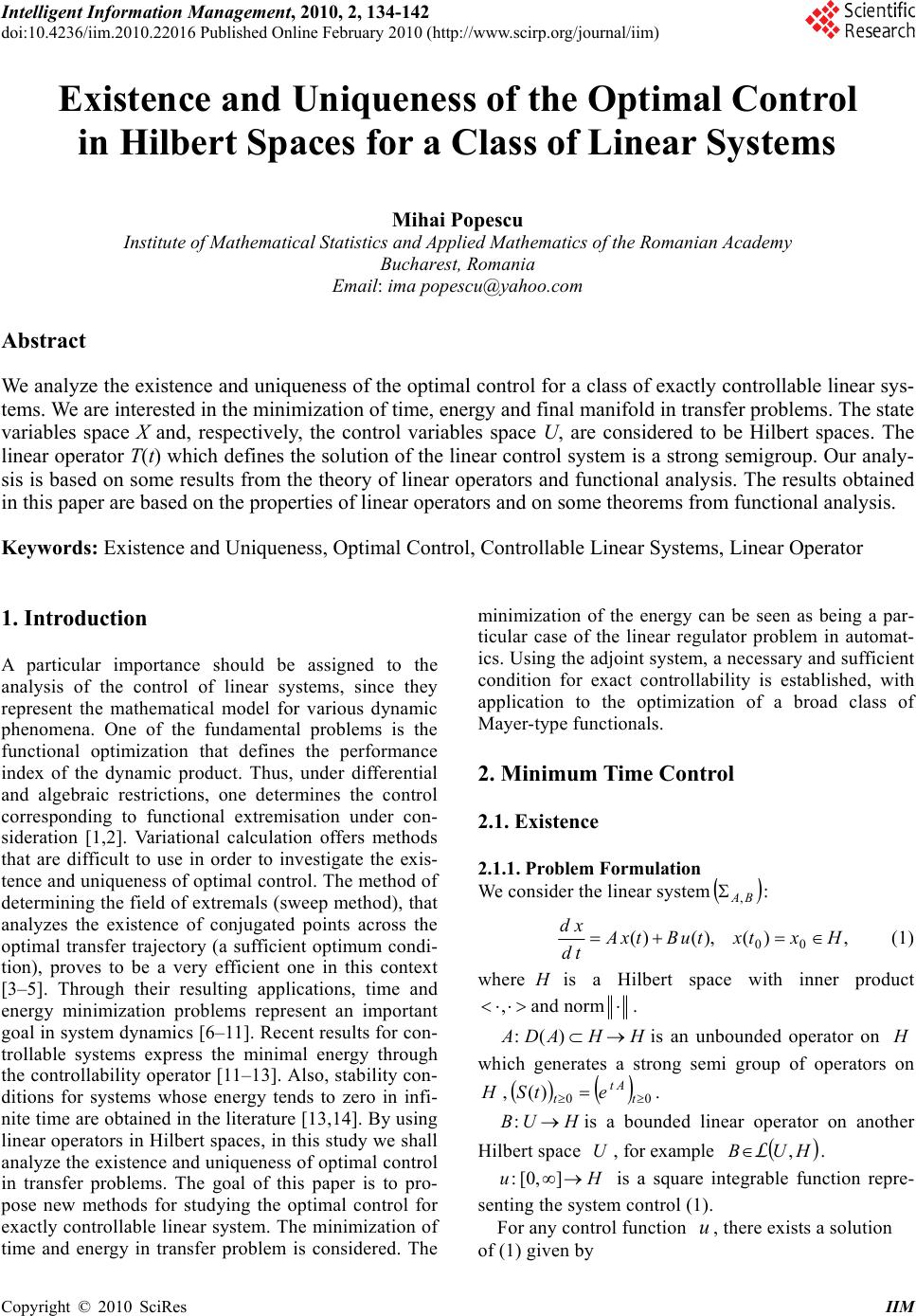 Intelligent Information Management, 2010, 2, 134-142 doi:10.4236/iim.2010.22016 Published Online February 2010 (http://www.scirp.org/journal/iim) Copyright © 2010 SciRes IIM Existence and Uniqueness of the Optimal Control in Hilbert Spaces for a Class of Linear Systems Mihai Popescu Institute of Mathematical Statistics and Applied Mathematics of the Romanian Academy Bucharest, Romania Email: ima popescu@yahoo.com Abstract We analyze the existence and uniqueness of the optimal control for a class of exactly controllable linear sys- tems. We are interested in the minimization of time, energy and final manifold in transfer problems. The state variables space X and, respectively, the control variables space U, are considered to be Hilbert spaces. The linear operator T(t) which defines the solution of the linear control system is a strong semigroup. Our analy- sis is based on some results from the theory of linear operators and functional analysis. The results obtained in this paper are based on the properties of linear operators and on some theorems from functional analysis. Keywords: Existence and Uniqueness, Optimal Control, Controllable Linear Systems, Linear Operator 1. Introduction A particular importance should be assigned to the analysis of the control of linear systems, since they represent the mathematical model for various dynamic phenomena. One of the fundamental problems is the functional optimization that defines the performance index of the dynamic product. Thus, under differential and algebraic restrictions, one determines the control corresponding to functional extremisation under con- sideration [1,2]. Variational calculation offers methods that are difficult to use in order to investigate the exis- tence and uniqueness of optimal control. The method of determining the field of extremals (sweep method), that analyzes the existence of conjugated points across the optimal transfer trajectory (a sufficient optimum condi- tion), proves to be a very efficient one in this context [3–5]. Through their resulting applications, time and energy minimization problems represent an important goal in system dynamics [6–11]. Recent results for con- trollable systems express the minimal energy through the controllability operator [11–13]. Also, stability con- ditions for systems whose energy tends to zero in infi- nite time are obtained in the literature [13,14]. By using linear operators in Hilbert spaces, in this study we shall analyze the existence and uniqueness of optimal control in transfer problems. The goal of this paper is to pro- pose new methods for studying the optimal control for exactly controllable linear system. The minimization of time and energy in transfer problem is considered. The minimization of the energy can be seen as being a par- ticular case of the linear regulator problem in automat- ics. Using the adjoint system, a necessary and sufficient condition for exact controllability is established, with application to the optimization of a broad class of Mayer-type functionals. 2. Minimum Time Control 2.1. Existence 2.1.1. Problem Formulation We consider the linear system BA, : ,)(),()( 00 HxtxtuBtxA td xd (1) where H is a Hilbert space with inner product ,and norm. HHADA )(: is an unbounded operator on H which generates a strong semi group of operators on H , 0 0 )( t At tetS . HUB :is a bounded linear operator on another Hilbert space , for example . U HUB ,L Hu ],0[: is a square integrable function repre- senting the system control (1). For any control function , there exists a solution u of (1) given by 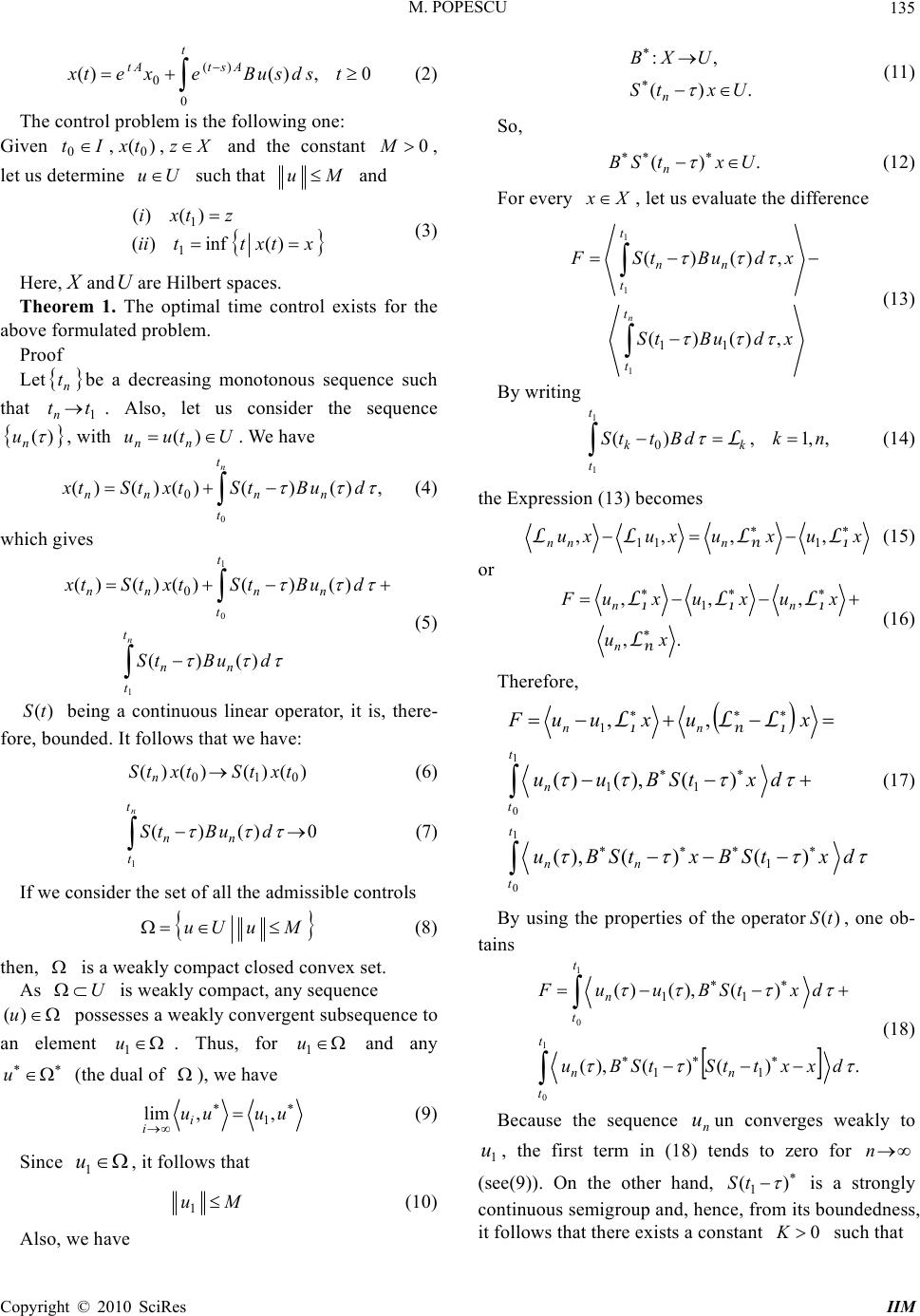 M. POPESCU 135 0,)()( 0 )( 0 tsdsuBexetx t AstAt (2) The control problem is the following one: Given , , It 0)( 0 tx X z U and the constant , let us determine such that 0M uMu and xtxttii ztxi )(inf)( )()( 1 1 (3) Here, X andUare Hilbert spaces. Theorem 1. The optimal time control exists for the above formulated problem. Proof Let be a decreasing monotonous sequence such that . Also, let us consider the sequence n t ttn ) 1 ( n u, with . We have Utuu nn )( ,)()()()()( 0 0 n t t nnnn duBtStxtStx (4) which gives n t t nn t t nnnn duBtS duBtStxtStx 1 1 0 )()( )()()()()( 0 (5) )(tS being a continuous linear operator, it is, there- fore, bounded. It follows that we have: )()()()( 010 txtStxtS n (6) 0)()( 1 n t t nnduBtS (7) If we consider the set of all the admissible controls MuUu (8) then, is a weakly compact closed convex set. As is weakly compact, any sequence U )(u u possesses a weakly convergent subsequence to an element . Thus, for and any (the dual of ), we have 1 u 1 u uuuui i,,lim1 (9) Since , it follows that 1 u Mu 1 (10) Also, we have .)( ,: UxtS UXB n (11) So, .)(UxtSB n (12) For every Xx , let us evaluate the difference xduBtS xduBtSF n t t t t nn ,)()( ,)()( 1 1 1 11 (13) By writing ,,1,)( 1 1 0nkdBttS k t t k L (14) the Expression (13) becomes xuxuxuxu nnn 1n LLLL ,,,, 111 (15) or ., ,,, 1 xu xuxuxuF n nn n 111 L LLL (16) Therefore, dxtSBxtSBu dxtSBuu xuxuuF t t nn t t n nn 1 0 1 0 )()(),( )(),()( ,, 1 11 11n1 LLL (17) By using the properties of the operator, one ob- tains )(tS .)()(),( )(),()( 1 0 1 0 11 11 dxxttStSBu dxtSBuuF t t nn t t n (18) Because the sequence un converges weakly to , the first term in (18) tends to zero for n u 1 u n (see(9)). On the other hand, is a strongly continuous semigroup and, hence, from its boundedness, it follows that there exists a constant such that )( 1 tS K0 Copyright © 2010 SciRes IIM 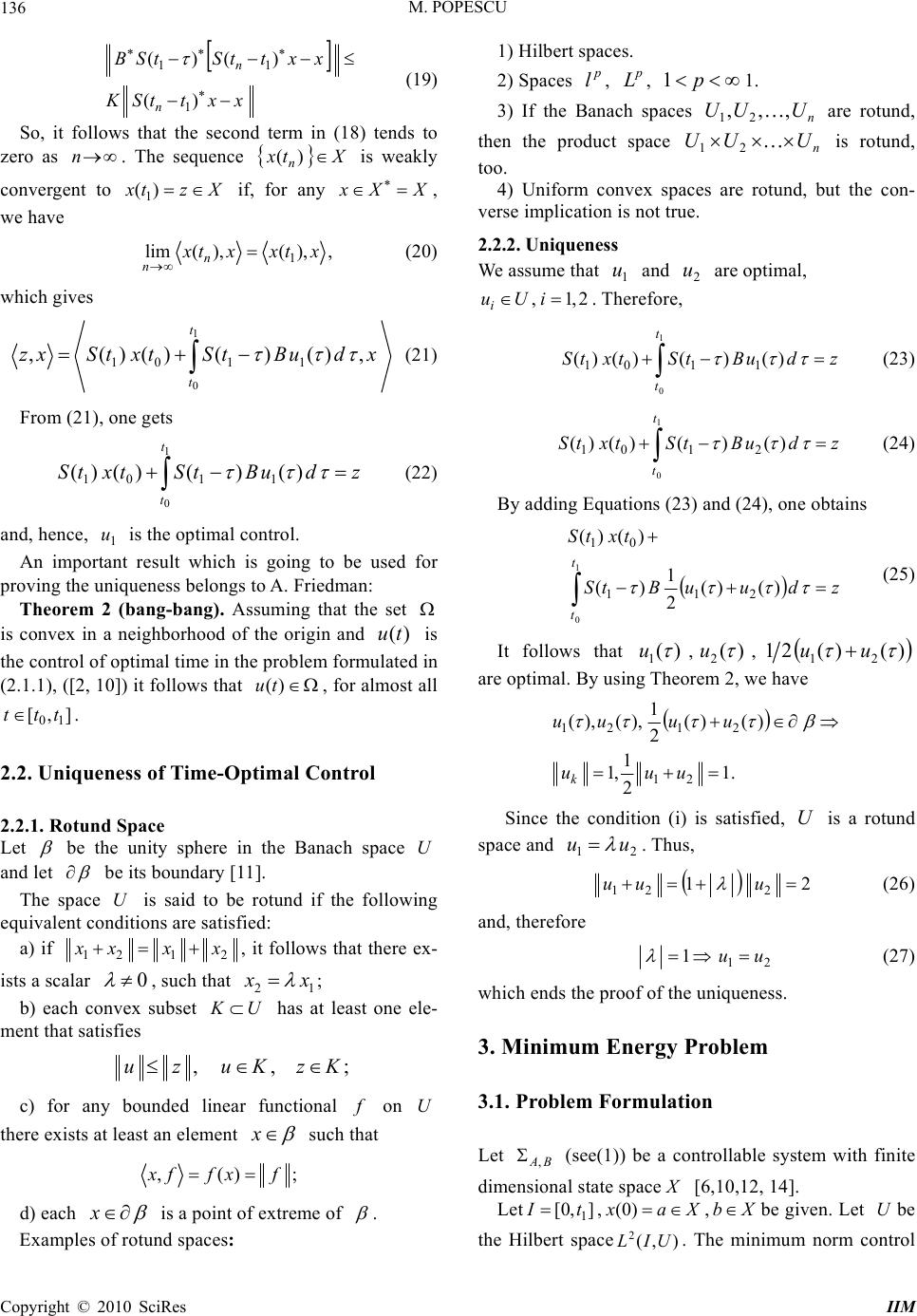 M. POPESCU 136 xxttSK xxttStSB n n )( )()( 1 11 (19) So, it follows that the second term in (18) tends to zero as . The sequence is weakly convergent to if, for any , we have n Xtx n)( xXztx )(1XX ,),(),(lim1xtxxtx n n (20) which gives xduBtStxtSxz t t ,)()()()(, 1 0 1101 (21) From (21), one gets zduBtStxtS t t 1 0 )()()()( 1101 (22) and, hence, is the optimal control. 1 u An important result which is going to be used for proving the uniqueness belongs to A. Friedman: Theorem 2 (bang-bang). Assuming that the set is convex in a neighborhood of the origin and is the control of optimal time in the problem formulated in (2.1.1), ([2, 10]) it follows that , for almost all . )(tu )(tu ],[ 10ttt 2.2. Uniqueness of Time-Optimal Control 2.2.1. Rotund Space Let be the unity sphere in the Banach space U and let be its boundary [11]. The space is said to be rotund if the following equivalent conditions are satisfied: U a) if 2121 xxxx , it follows that there ex- ists a scalar 0 , such that 12 xx ; b) each convex subset has at least one ele- ment that satisfies UK ;,, KzKuzu c) for any bounded linear functional on there exists at least an element f U x such that ;)(,fxffx d) each x is a point of extreme of . Examples of rotund spaces: 1) Hilbert spaces. 2) Spaces , , p lp L p11. 3) If the Banach spaces are rotund, then the product space U is rotund, too. n UUU ,,, 21 n UU 21 4) Uniform convex spaces are rotund, but the con- verse implication is not true. 2.2.2. Uniqueness We assume that and are optimal, 1 u2 u 2,1, iUui. Therefore, zduBtStxtS t t 1 0 )()()()( 1101 (23) zduBtStxtS t t 1 0 )()()()( 2101 (24) By adding Equations (23) and (24), one obtains zduuBtS txtS t t 1 0 )()( 2 1 )( )()( 211 01 (25) It follows that )( 1 u,)( 2 u, )()(2121 uu are optimal. By using Theorem 2, we have .1 2 1 ,1 )()( 2 1 ),(),( 21 2121 uuu uuuu k Since the condition (i) is satisfied, is a rotund space and U 21 uu . Thus, 21 221 uuu (26) and, therefore 21 1uu (27) which ends the proof of the uniqueness. 3. Minimum Energy Problem 3.1. Problem Formulation Let (see(1)) be a controllable system with finite dimensional state space BA, X [6,10,12, 14]. Let ],0[ 1 tI ,Xax )0( ),( 2UIL ,be given. Let be the Hilbert space. The minimum norm control Xb U Copyright © 2010 SciRes IIM 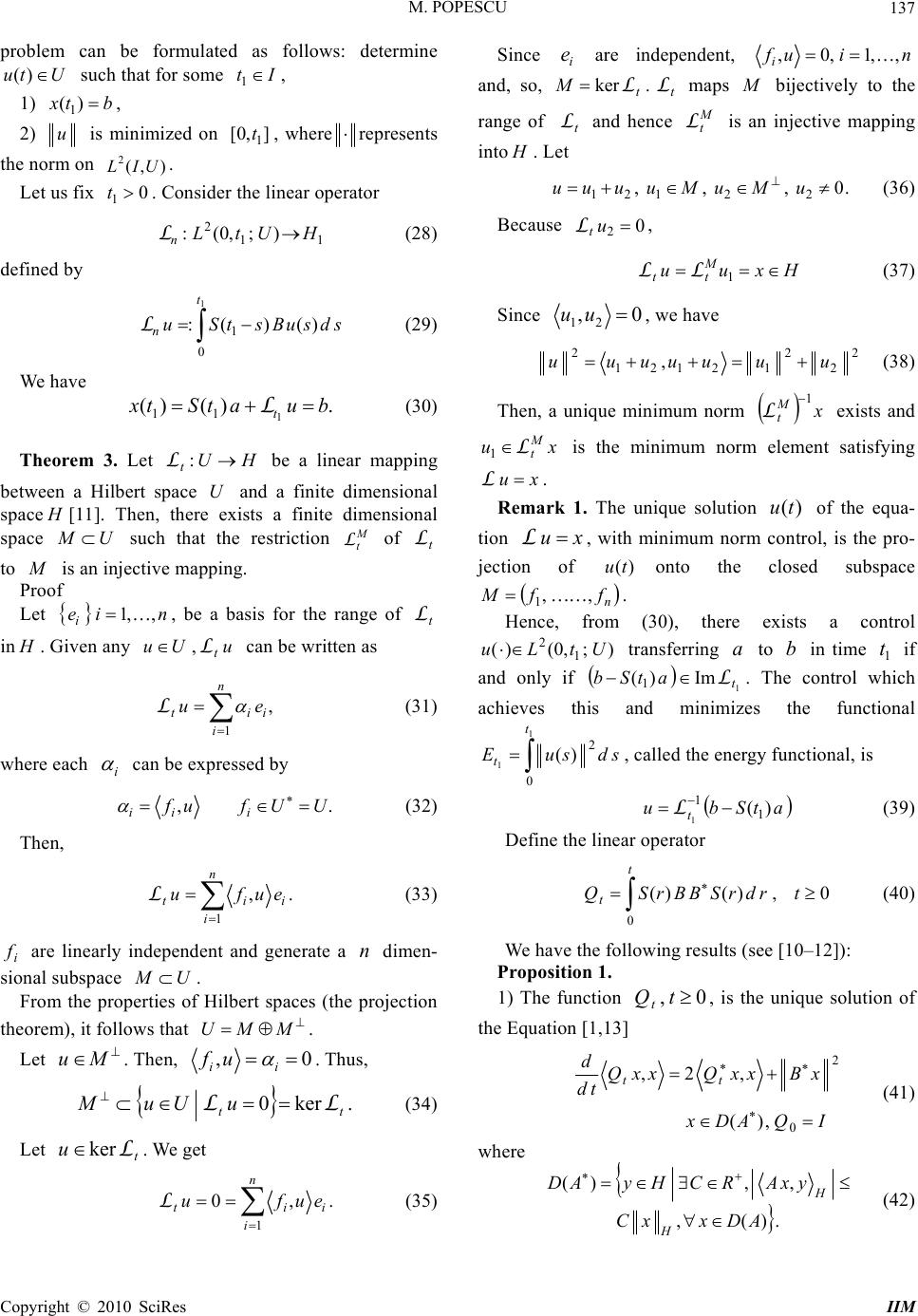 M. POPESCU 137 problem can be formulated as follows: determine such that for some , Utu )( tx(1 It 1 1) , b) 2) u is minimized on , where],0[ 1 trepresents the norm on . ),( 2UIL Let us fix . Consider the linear operator 0 1t 1 20(: HL nL1);,Ut 1)Bst 1 at L H (28) defined by 1 0 )((: t nsdsuSuL (29) We have .)()( 11 butStx (30) Theorem 3. Let be a linear mapping between a Hilbert space and a finite dimensional space U t:L U H [11]. Then, there exists a finite dimensional space such that the restriction of to UMM t Lt L M is an injective mapping. Proof Let , be a basis for the range of in niei,,1 t L H . Given any , can be written as Uu u t L , ii e 1 n i tuL (31) where each i can be expressed by ., UUfiufii (32) Then, . 1 n i tuL,ii euf (33) i f are linearly independent and generate a dimen- sional subspace . n UM From the properties of Hilbert spaces (the projection theorem), it follows that . MMU Let . Then, Mu 0, ii uf . Thus, .ker0 tt uUuM LL (34) Let . We get t uLker .,0 1 n i iit eufuL (35) Since are independent, i eniufi,,1,0, and, so, . maps t LkerMt L M bijectively to the range of and hence is an injective mapping into t LM t L H . Let .0,,, 22121 uMuMuuuu (36) Because , 0 2u t L Hxuu M tt 1 LL (37) Since 0, 21 uu , we have 2 2 2 12121 2,uuuuuuu (38) Then, a unique minimum norm exists and is the minimum norm element satisfying x M t 1 L xu M t L 1 xu L. Remark 1. The unique solution of the equa- tion )(tu xu L, with minimum norm control, is the pro- jection of onto the closed subspace )(tu n ff,, 1M . Hence, from (30), there exists a control transferring to in time if and only if );,0()( 1 2UtLu a b1 t Im)( 1atS 1 t Lb . The control which achieves this and minimizes the functional 1 1 0 2 )( t tsdsuE, called the energy functional, is atSbu t)( 1 1 1 L (39) Define the linear operator 0,)()( 0 trdrSBBrSQ t t (40) We have the following results (see [10–12]): Proposition 1. 1) The function , is the unique solution of the Equation [1,13] 0, tQt IQADx xBxxQxxQ td d tt 0 2 ,)( ,2, (41) where .)(, ,,)( ADxxC yxARCHyAD H H (42) Copyright © 2010 SciRes IIM 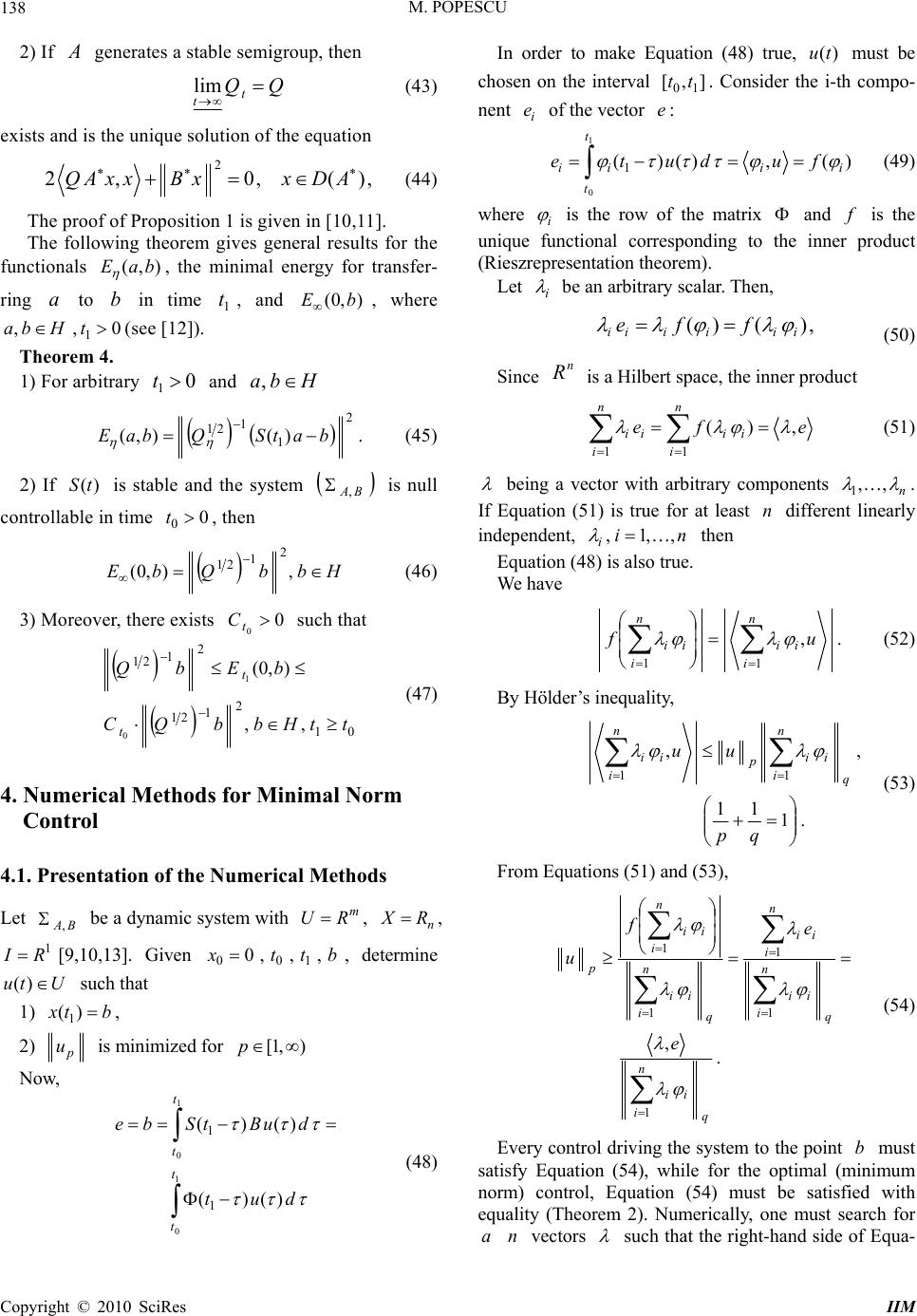 M. POPESCU 138 2) If generates a stable semigroup, then A QQt t lim (43) exists and is the unique solution of the equation ,)(,0,22 ADxxBxxAQ (44) The proof of Proposition 1 is given in [10,11]. The following theorem gives general results for the functionals , the minimal energy for transfer- ring to in time , and , where ,t(see [12]). ),(baE b 0 a H 1 t),0(bE ba,1 Theorem 4. 1) For arbitrary and 0 1tHba , .)(),( 2 1 1 21 batSQbaE (45) 2) If is stable and the system )(tS BA, is null controllable in time , then 0 0t HbbQbE ,),0( 2 1 21 (46) 3) Moreover, there exists such that 0 0 t C 01 2 1 21 2 1 21 ,, ),0( 0 1 ttHbbQC bEbQ t t (47) 4. Numerical Methods for Minimal Norm Control 4.1. Presentation of the Numerical Methods Let be a dynamic system with , BA, m RU n RX , 1 R I [9,10,13]. Given 0 0 x,, , , determine such that 0 t1 tb U)tu( 1) , btx )( 1 2) p u is minimized for ),1[p Now, 1 0 1 0 )()( )()( 1 1 t t t t dut duBtSbe (48) In order to make Equation (48) true, must be chosen on the interval . Consider the i-th compo- nent of the vector : )(tu ],[ 10tt e i e )(,)()( 1 0 1ii t t ii fudute (49) where i is the row of the matrix and is the unique functional corresponding to the inner product (Rieszrepresentation theorem). f Let i be an arbitrary scalar. Then, ,)()( iiiiiiffe (50) Since n R is a Hilbert space, the inner product efe n i ii n i ii ,)( 11 (51) being a vector with arbitrary components n ,, 1. If Equation (51) is true for at least different linearly independent, n ni i,,1, then Equation (48) is also true. We have ., 11 uf n i ii n i ii (52) By Hölder’s inequality, .1 11 ,, 11 qp uu q n i ii p n i ii (53) From Equations (51) and (53), . , 1 1 1 1 1 q n i ii q n i ii n i ii q n i ii n i ii p e e f u (54) Every control driving the system to the point must satisfy Equation (54), while for the optimal (minimum norm) control, Equation (54) must be satisfied with equality (Theorem 2). Numerically, one must search for vectors b a n such that the right-hand side of Equa- Copyright © 2010 SciRes IIM 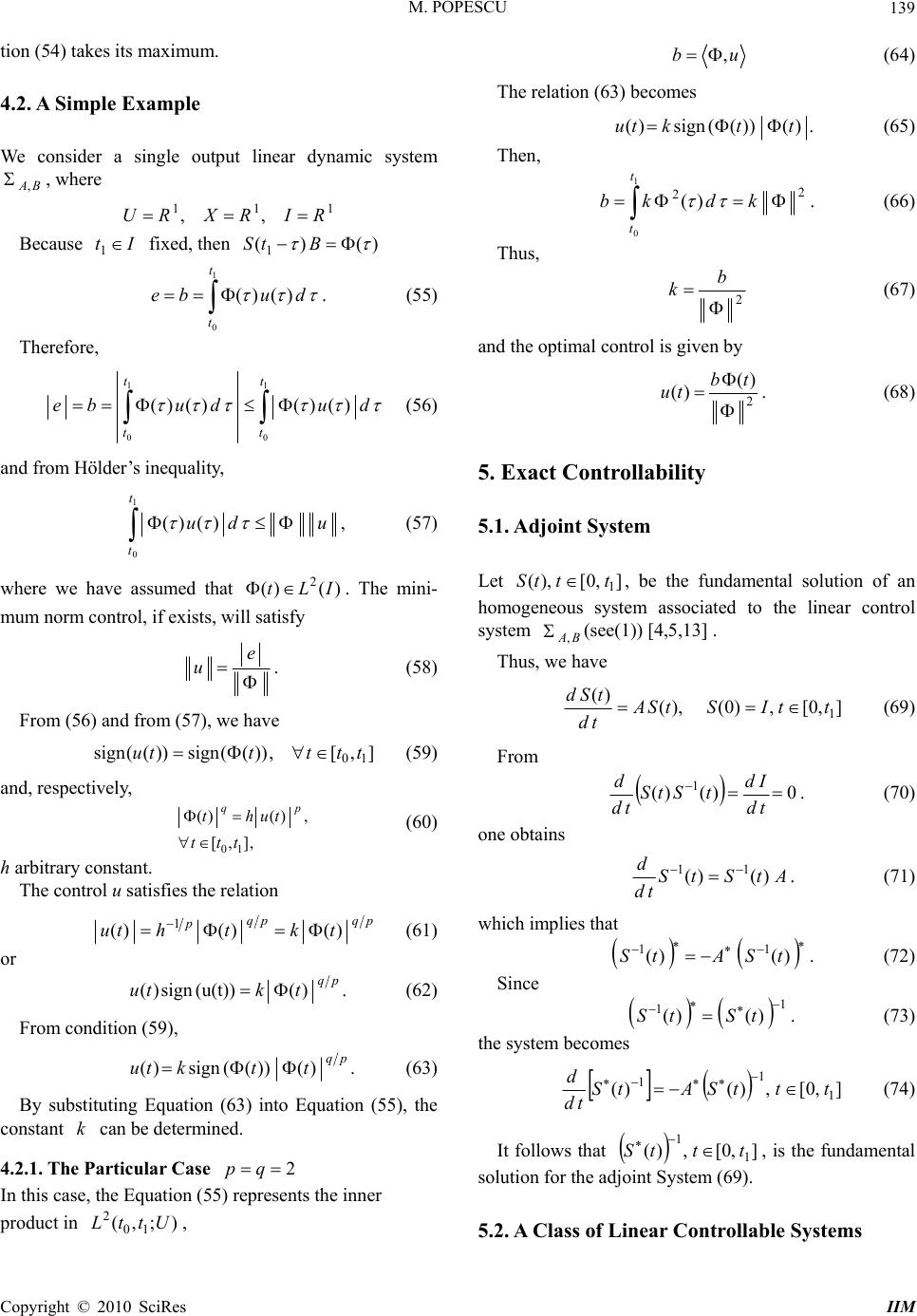 M. POPESCU 139 tion (54) takes its maximum. 4.2. A Simple Example We consider a single output linear dynamic system , where BA, 111 ,, RIRXRU Because fixed, then It 1)()( 1 BtS 1 0 .)()( t t dube (55) Therefore, 1 0 1 0 )()()()( t t t t dudube (56) and from Hölder’s inequality, ,)()( 1 0 udu t t (57) where we have assumed that . The mini- mum norm control, if exists, will satisfy )()( 2ILt . e u (58) From (56) and from (57), we have ],[,))((sign))((sign 10tttttu (59) and, respectively, ,],[ ,)()( 10ttt tuhtpq (60) h arbitrary constant. The control u satisfies the relation pqpq ptkthtu )()()( 1 (61) or .)((u(t))sign)( pq tktu (62) From condition (59), .)())((sign)( pq ttktu (63) By substituting Equation (63) into Equation (55), the constant can be determined. k 4.2.1. The Particular Case 2 qp In this case, the Equation (55) represents the inner product in , );,(10 2UttL ub , (64) The relation (63) becomes .)())((sign)( ttktu (65) Then, .)( 2 2 1 0 kdkb t t (66) Thus, 2 b k (67) and the optimal control is given by . )( )( 2 tb tu (68) 5. Exact Controllability 5.1. Adjoint System Let ],0[),( 1 tttS , be the fundamental solution of an homogeneous system associated to the linear control system (see(1)) [4,5,13] . BA, Thus, we have ],0[,)0(),( )( 1 ttIStSA td tSd (69) From .0)()( 1 td Id tStS td d (70) one obtains .)()( 11 AtStS td d (71) which implies that .)()( 11 tSAtS (72) Since .)()( 1 1 tStS (73) the system becomes ],0[,)()( 1 1 1tttSAtS td d (74) It follows that ],0[,)( 1 1tttS , is the fundamental solution for the adjoint System (69). 5.2. A Class of Linear Controllable Systems Copyright © 2010 SciRes IIM 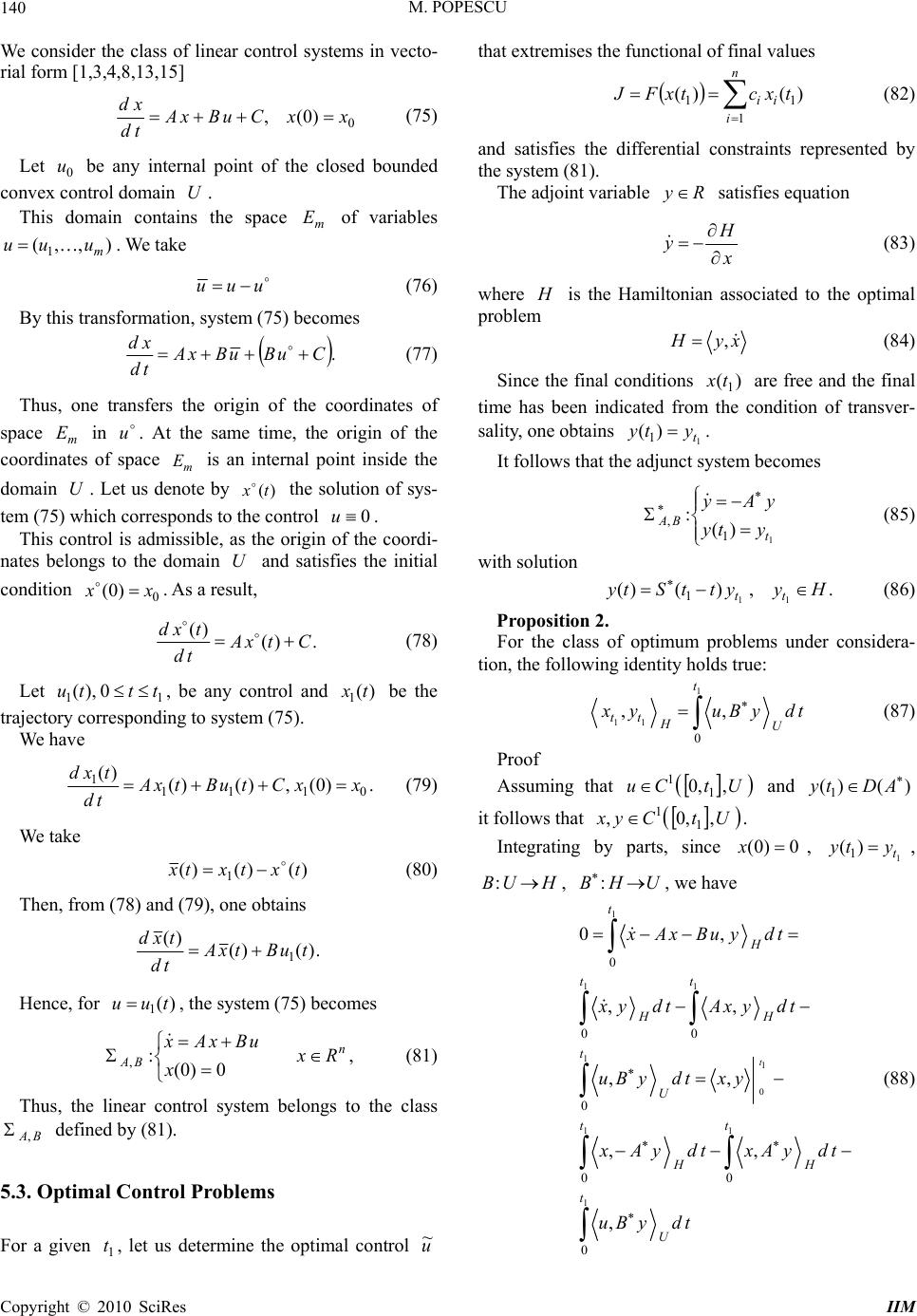 M. POPESCU 140 We consider the class of linear control systems in vecto- rial form [1,3,4,8,13,15] 0 )0(, xxCuBxA td xd (75) Let be any internal point of the closed bounded convex control domain . 0 u U This domain contains the space of variables . We take m E ),,( 1m uuu uuu (76) By this transformation, system (75) becomes .CuBuBxA td xd (77) Thus, one transfers the origin of the coordinates of space in . At the same time, the origin of the coordinates of space is an internal point inside the domain . Let us denote by the solution of sys- tem (75) which corresponds to the control . m E U u m E )(tx 0u This control is admissible, as the origin of the coordi- nates belongs to the domain and satisfies the initial condition . As a result, U 0 )0( xx .)( )( CtxA td txd (78) Let , be any control and be the trajectory corresponding to system (75). 110),(tttu )( 1tx We have .)0(,)()( )( 0111 1xxCtuBtxA td txd (79) We take )()()( 1txtxtx (80) Then, from (78) and (79), one obtains .)()( )( 1tuBtxA td txd Hence, for , the system (75) becomes )( 1tuu , 0)0( : , n BARx x uBxAx (81) Thus, the linear control system belongs to the class defined by (81). BA, 5.3. Optimal Control Problems For a given , let us determine the optimal control 1 tu ~ that extremises the functional of final values n i ii txctxFJ 1 11 )()( (82) and satisfies the differential constraints represented by the system (81). The adjoint variable Ry satisfies equation x H y (83) where H is the Hamiltonian associated to the optimal problem xyH , (84) Since the final conditions are free and the final time has been indicated from the condition of transver- sality, one obtains )(1 tx 1 )(1t yty . It follows that the adjunct system becomes 1 )( : 1 , t BA yty yAy (85) with solution .,)()( 11 1HyyttStytt (86) Proposition 2. For the class of optimum problems under considera- tion, the following identity holds true: 1 11 0 ,, t U H tt tdyBuyx (87) Proof Assuming that UtCu ,,01 1 and it follows that )()( 1 ADty UtCy ,,01 1 x,. Integrating by parts, since , 0)0( x1 )( 1t yty , , , we have HUB :UHB : 1 11 1 0 1 11 1 0 00 0 00 0 , ,, ,, ,, ,0 t U t H t H t U t H t H t H tdyBu tdyAxtdyAx yxtdyBu tdyxAtdyx tdyuBxAx t (88) Copyright © 2010 SciRes IIM 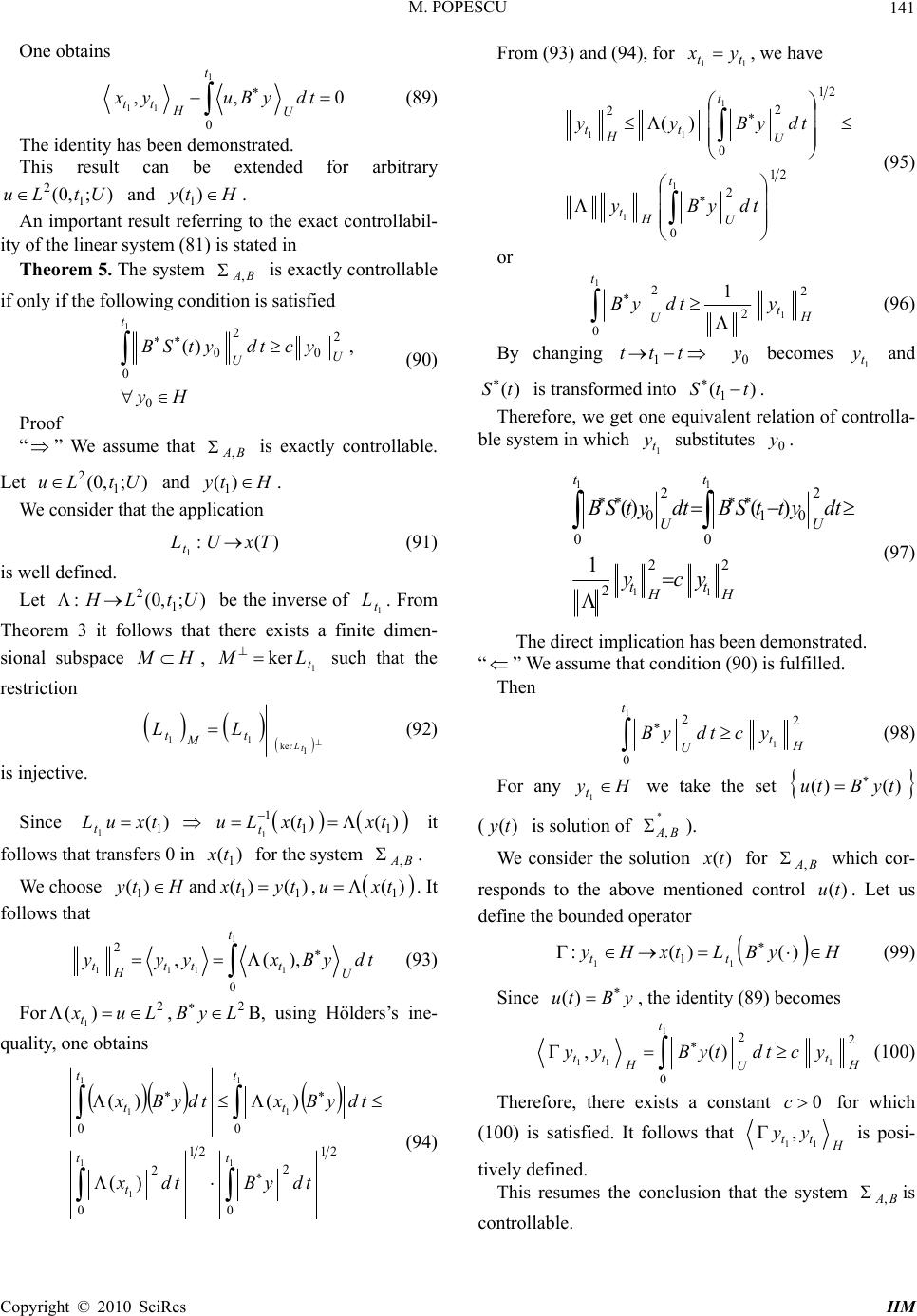 M. POPESCU 141 One obtains 0,, 1 11 0 t U H tt tdyBuyx (89) The identity has been demonstrated. This result can be extended for arbitrary and . );,0(1 2UtLu Hty )(1 An important result referring to the exact controllabil- ity of the linear system (81) is stated in Theorem 5. The system is exactly controllable if only if the following condition is satisfied BA, Hy yctdytSB U t U 0 2 0 0 2 0,)( 1 (90) Proof “” We assume that is exactly controllable. Let and BA, ty);,0(1 2UtLu H )(1. We consider that the application )(: 1TxULt (91) is well defined. Let be the inverse of . From Theorem 3 it follows that there exists a finite dimen- sional subspace );,0(:1 2UtLH 1 t L H M , such that the restriction 1 ker t LM 1 ker 11 t L t M tLL (92) is injective. Since it follows that transfers 0 in for the system . )(1 1txuLt )()(11 1 1txtxLu t )( 1 tx BA, We choose ynd xHt )( 1a)()( 11 tyt , )(1 txu . It follows that 1 1111 0 2),(, t U ttt H ttdyBxyyy (93) For ,B, using Hölders’s ine- quality, one obtains 2 )( 1Luxt 2 LyB 21 0 2 21 0 2 00 11 1 1 1 1 1 )( )()( tt t t t t t tdyBtdx tdyBxtdyBx (94) From (93) and (94), for , we have 11 tt yx 21 0 2 21 0 2 2 1 1 1 11)( t U H t t U t H t tdyBy tdyByy (95) or 2 2 0 2 1 11 H t t UytdyB (96) By changing ttt 1 (S becomes and is transformed into . 0 y ) 1t 1 t y )(tSt Therefore, we get one equivalent relation of controlla- ble system in which substitutes . 1 t y0 y 22 2 0 2 01 0 2 0 11 11 1 )()( H t H t t U t U ycy tdyttSBtdytSB (97) The direct implication has been demonstrated. “ ” We assume that condition (90) is fulfilled. Then 2 0 2 1 1 H t t UyctdyB (98) For any Hyt 1 we take the set )()(tyBtu ( is solution of ). )(ty BA, We consider the solution for which cor- responds to the above mentioned control . Let us define the bounded operator )(tx BA, u)(t HyBLtxHytt )()(: 11 1 (99) Since , the identity (89) becomes yBtu )( 2 0 2 1 1 11 )(, H t t U H tt yctdtyByy (100) Therefore, there exists a constant for which (100) is satisfied. It follows that 0c H tt yy 11, is posi- tively defined. This resumes the conclusion that the system is controllable. BA, Copyright © 2010 SciRes IIM 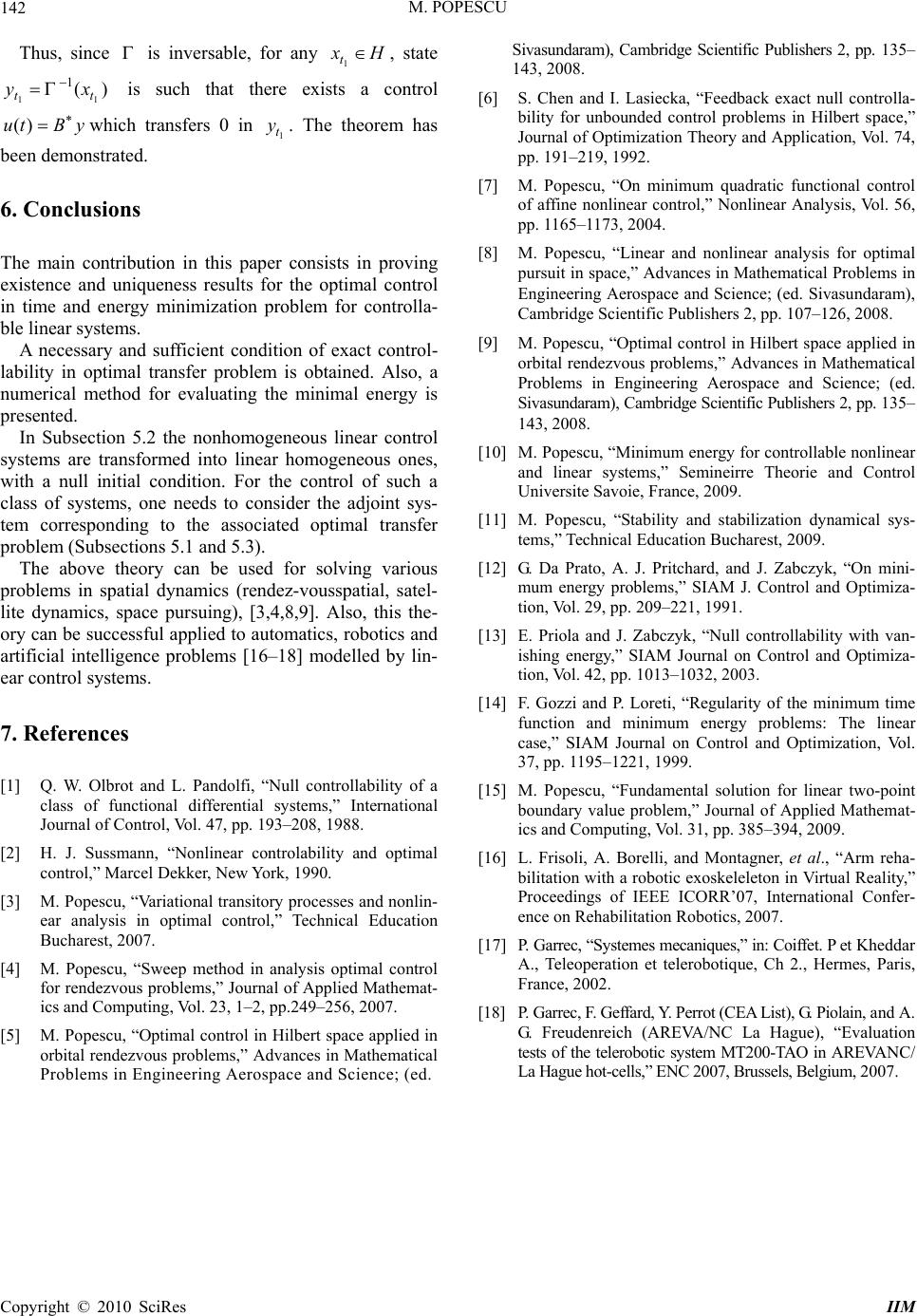 M. POPESCU Copyright © 2010 SciRes IIM 142 Thus, since is inversable, for any , state is such that there exists a control which transfers 0 in . The theorem has been demonstrated. Hxt 1 )( 11 1 ttxy yBtu )( 1 t y 6. Conclusions The main contribution in this paper consists in proving existence and uniqueness results for the optimal control in time and energy minimization problem for controlla- ble linear systems. A necessary and sufficient condition of exact control- lability in optimal transfer problem is obtained. Also, a numerical method for evaluating the minimal energy is presented. In Subsection 5.2 the nonhomogeneous linear control systems are transformed into linear homogeneous ones, with a null initial condition. For the control of such a class of systems, one needs to consider the adjoint sys- tem corresponding to the associated optimal transfer problem (Subsections 5.1 and 5.3). The above theory can be used for solving various problems in spatial dynamics (rendez-vousspatial, satel- lite dynamics, space pursuing), [3,4,8,9]. Also, this the- ory can be successful applied to automatics, robotics and artificial intelligence problems [16–18] modelled by lin- ear control systems. 7. References [1] Q. W. Olbrot and L. Pandolfi, “Null controllability of a class of functional differential systems,” International Journal of Control, Vol. 47, pp. 193–208, 1988. [2] H. J. Sussmann, “Nonlinear controlability and optimal control,” Marcel Dekker, New York, 1990. [3] M. Popescu, “Variational transitory processes and nonlin- ear analysis in optimal control,” Technical Education Bucharest, 2007. [4] M. Popescu, “Sweep method in analysis optimal control for rendezvous problems,” Journal of Applied Mathemat- ics and Computing, Vol. 23, 1–2, pp.249–256, 2007. [5] M. Popescu, “Optimal control in Hilbert space applied in orbital rendezvous problems,” Advances in Mathematical Problems in Engineering Aerospace and Science; (ed. Sivasundaram), Cambridge Scientific Publishers 2, pp. 135– 143, 2008. [6] S. Chen and I. Lasiecka, “Feedback exact null controlla- bility for unbounded control problems in Hilbert space,” Journal of Optimization Theory and Application, Vol. 74, pp. 191–219, 1992. [7] M. Popescu, “On minimum quadratic functional control of affine nonlinear control,” Nonlinear Analysis, Vol. 56, pp. 1165–1173, 2004. [8] M. Popescu, “Linear and nonlinear analysis for optimal pursuit in space,” Advances in Mathematical Problems in Engineering Aerospace and Science; (ed. Sivasundaram), Cambridge Scientific Publishers 2, pp. 107–126, 2008. [9] M. Popescu, “Optimal control in Hilbert space applied in orbital rendezvous problems,” Advances in Mathematical Problems in Engineering Aerospace and Science; (ed. Sivasundaram), Cambridge Scientific Publishers 2, pp. 135– 143, 2008. [10] M. Popescu, “Minimum energy for controllable nonlinear and linear systems,” Semineirre Theorie and Control Universite Savoie, France, 2009. [11] M. Popescu, “Stability and stabilization dynamical sys- tems,” Technical Education Bucharest, 2009. [12] G. Da Prato, A. J. Pritchard, and J. Zabczyk, “On mini- mum energy problems,” SIAM J. Control and Optimiza- tion, Vol. 29, pp. 209–221, 1991. [13] E. Priola and J. Zabczyk, “Null controllability with van- ishing energy,” SIAM Journal on Control and Optimiza- tion, Vol. 42, pp. 1013–1032, 2003. [14] F. Gozzi and P. Loreti, “Regularity of the minimum time function and minimum energy problems: The linear case,” SIAM Journal on Control and Optimization, Vol. 37, pp. 1195–1221, 1999. [15] M. Popescu, “Fundamental solution for linear two-point boundary value problem,” Journal of Applied Mathemat- ics and Computing, Vol. 31, pp. 385–394, 2009. [16] L. Frisoli, A. Borelli, and Montagner, et al., “Arm reha- bilitation with a robotic exoskeleleton in Virtual Reality,” Proceedings of IEEE ICORR’07, International Confer- ence on Rehabilitation Robotics, 2007. [17] P. Garrec, “Systemes mecaniques,” in: Coiffet. P et Kheddar A., Teleoperation et telerobotique, Ch 2., Hermes, Paris, France, 2002. [18] P. Garrec, F. Geffard, Y. Perrot (CEA List), G. Piolain, and A. G. Freudenreich (AREVA/NC La Hague), “Evaluation tests of the telerobotic system MT200-TAO in AREVANC/ La Hague hot-cells,” ENC 2007, Brussels, Belgium, 2007. |

